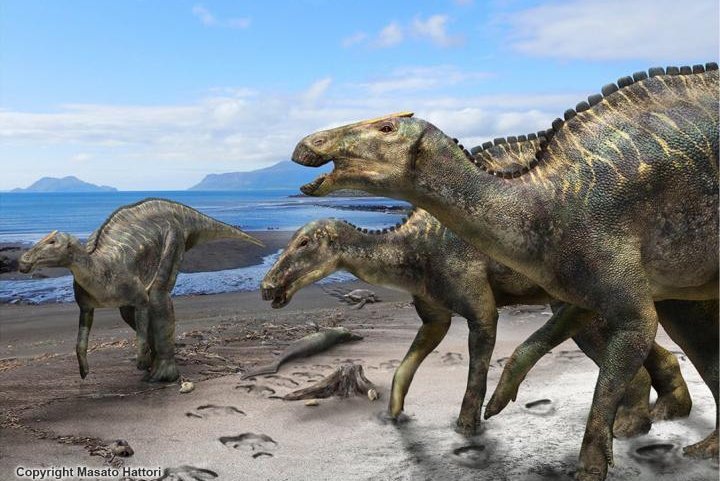An artistic rendering of the new duck-billed dinosaur species, Kamuysaurus japonicus. Photo by Masato/Hattori/Kobayashi Y., et al./Scientific Reports
Sept. 5 (UPI) -- Paleontologists have unearthed the near complete skeleton of a new species of duck-billed dinosaur in northern Japan.
The 72-million-year-old remains were recovered from marine shelf deposits comprising the Upper Cretaceous Hakobuchi Formation, located near the town of Mukawa on the island of Hokkaido.
Researchers compared the specimen's 350 bones with those of 70 types of duck-billed dinosaurs, or hadrosaurids. They determined the specimen warranted a new genus and species classification, naming the dino Kamuysaurus japonicus.
The new species, described Thursday in the journal Scientific Reports, belongs to the Edmontosaurini clade and is closely related to members of the genera Kerberosaurus and Laiyangosaurus. The dinosaur lived during the Late Cretaceous Period, which lasted from 100.5 to 66 million years ago.
Scientists determined the specimen's cranial bone notch is positioned lower than its relatives. The ascending portion of the dinosaur's jaw is also shorter than other duck-billed dinosaurs. Unlike its relatives, the species featured a short row of neural spines that point forward.
Kamuysaurus japonicus stretched nearly 30 feet in length as an adult and weighed between four and five tons.
The discovery offered scientists further proof of the diversity and adaptability of hadrosaurids, as few duck-billed dinosaurs have been found in marine deposits.
Though the skeleton was remarkably well-preserved, it wasn't totally complete. Some bones were missing, while others were damaged. The skull's frontal bone features a large articular facet that connects to the nasal bone, which suggests the dinosaur may have boasted a crest similar to those sported by Brachylophosaurus, a species found in North America.
An ancient land bridge would have enabled members of the Edmontosaurini clade to migrate back and forth between Asia and North America. In fact, the authors of the new study hypothesized that Kamuysaurus, Laiyangosaurus, and Kerberosaurus dinosaurs likely migrated from North America into Asia, dispersing and diversifying prior to the end of the Campanian, the fifth of six ages of the Late Cretaceous epoch.















